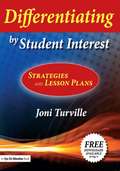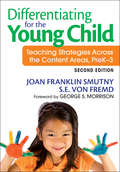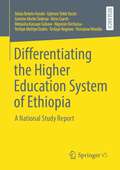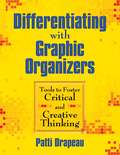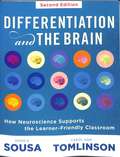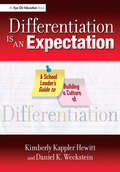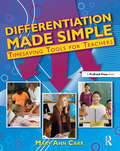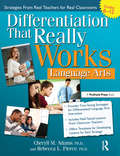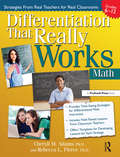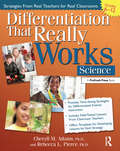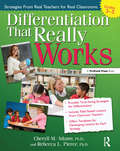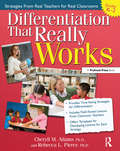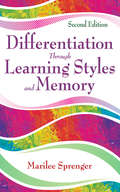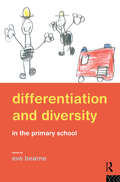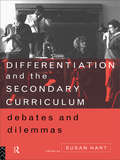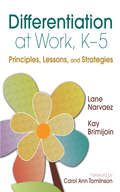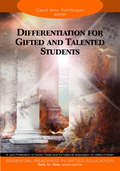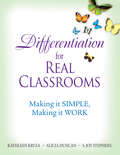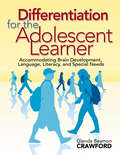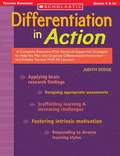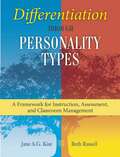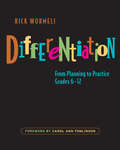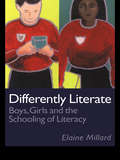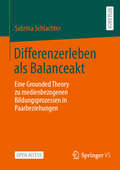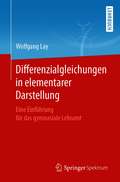- Table View
- List View
Differentiating by Student Interest: Practical Lessons and Strategies
by Joni TurvilleThis practical book shows elementary school teachers how to differentiate instruction based on their students' situational and personal interests. It provides a large number of detailed and easy-to-use lesson plans to help you create choices to increase student engagement and learning. Also included is a set of blackline masters which you can duplicate and use in your classroom.
Differentiating for the Young Child: Teaching Strategies Across the Content Areas, PreK–3
by Joan F. Smutny Sarah E. von FremdMeet the highly diverse needs of primary students with these differentiated teaching strategies! Designed to help primary teachers value and support the unique experiences and learning styles of diverse young learners, this book offers strategies for promoting intellectual discovery and creative thinking across key discipline areas, tackles issues related to underserved students, and discusses differentiated technology use. This second edition: Includes new charts with strategies for differentiating lessons in math, science, social studies, and language arts Presents new focus questions to help teachers clarify their own priorities and target student needs efficiently Offers Web sites for further reference
Differentiating the Higher Education System of Ethiopia: A National Study Report
by Adula Bekele Hunde Ephrem Tekle Yacob Genene Abebe Tadesse Kiros Guesh Mekasha Kassaye Gobaw Nigussie Dechassa Tesfaye Muhiye Endris Tesfaye Negewo Yemataw WondieThe Government of the Federal Democratic Republic of Ethiopia commissioned a national study to review the overall education system of Ethiopia in 2016 that resulted in the Education and Training Roadmap outlining the unwavering commitment towards transformative changes in the national education system. Among the various areas identified in the Roadmap for further intervention and urgent policy shift was the dire need to differentiate the public universities—which for ages have stagnated from disciplinary and mission redundancy—and transform them to vibrant 21st century dynamic universities endowed with missions commensurate with the critical needs of the country.
Differentiating with Graphic Organizers: Tools to Foster Critical and Creative Thinking
by Patti DrapeauGraphic organizers have proven to be successful tools for helping students develop their critical and creative thinking skills. This research-based resource shows how graphic organizers can improve teaching practices, help differentiate instruction in the classroom, and raise learning outcomes for all students, including English language learners and students with learning disabilities.The author presents graphic organizers for nine types of thinking processes based on Bloom's taxonomy and offers examples of how to apply the graphic organizers in different subject areas and grade levels. This hands-on guide demonstrates how teachers can:Promote the critical thinking processes of assuming, inferring, analyzing, prioritizing, and judgingEncourage the creative thinking processes of brainstorming, connecting, creating, and elaboratingModify graphic organizers or create their own to meet individual learning needsWith assessment rubrics for providing quality feedback included, Differentiating With Graphic Organizers addresses ways to promote and build students’ creative reasoning, communication, and problem-solving skills and make the learning process a success.
Differentiation And The Brain: How Neuroscience Supports The Learner-friendly Classroom
by Carol Ann Tomlinson David A. SousaStudents are becoming more academically and culturally diverse, making it more important than ever to shift away from a one-size-fits-all approach and toward differentiated instruction. The second edition of this best-selling book will help you create truly effective, brain-friendly classrooms for all learners. The authors share an array of updated differentiated instruction examples, scenarios, and exercises, as well as the latest educational psychology research from cognitive psychology, neuroscience, and pedagogy. Learn more about teaching diverse learners using brain-based learning strategies: Explore how the brain learns and approaches to differentiated instruction. Sharpen your knowledge of developmental cognitive neuroscience and educational psychology to teach the best content in the best possible way. Use the knowledge of educational neuroscience (neuroeducation) to benefit the students you teach. Design and implement strategies for effective differentiated instruction. Create a positive and productive learning environment that supports diversity in the classroom. A joint publication of ASCD and Solution Tree
Differentiation Is an Expectation: A School Leader's Guide to Building a Culture of Differentiation
by Daniel WecksteinTurn your school into a place where every child achieves. This book provides leaders with all that they need to promote differentiation in their schools and districts. Through research and first-hand experience, the authors have identified effective strategies for hiring differentiation-minded staff members, communicating the need for differentiation to all stakeholders, motivating teachers to differentiate, and using differentiated teacher evaluation to effect change.
Differentiation Made Simple: Timesaving Tools for Teachers
by Mary Ann CarrDifferentiation is a practice that is beneficial to every student. Rather than focusing on leaving no child behind, differentiation aims to move every child ahead. The trouble for many teachers is, however, that differentiating for all students can be time consuming. Differentiation Made Simple will help classroom teachers overcome time constraints and other obstacles to differentiation by providing a wealth of ready-made and generic tools they can employ right away. The tools include task cards for literature, creative writing, and research; tic-tac-toe menus; graphic organizers; and guides to creating differentiated units—each one tied to specific questions and concerns teachers have about differentiating instruction. Also included are product lists and other assessment ideas, including rubrics and a scoring conversion table. Written especially for teachers in the trenches, Differentiation Made Simple will help unlock the door to creating a classroom where every child is challenged by work appropriate for his or her abilities, interests, and learning styles.
Differentiation That Really Works: Language Arts (Grades 6-12)
by Cheryll M. Adams Rebecca L. PierceDifferentiation That Really Works: Language Arts provides time-saving tips and strategies from real teachers who teach language arts in grades 6-12. These teachers not only developed the materials and used them in their own classes, but they also provided useful feedback and comments about the activities. The strategies included in the book are tiered lessons, cubing, graphic organizers, exit cards, learning contracts, and choice boards. Every strategy includes directions and offers opportunities for differentiation.Grades 6-12
Differentiation That Really Works: Math (Grades 6-12)
by Cheryll M. Adams Rebecca L. PierceDifferentiation That Really Works: Math (6-12) provides time-saving tips and strategies from real teachers who teach math in grades 6-12. These teachers not only developed the materials and used them in their own classes, but they also provided useful feedback and comments about the activities. The strategies included in the book are tiered lessons, cubing, graphic organizers, exit cards, learning contracts, and choice boards. Every strategy includes directions and offers opportunities for differentiation.Grades 6-12
Differentiation That Really Works: Science (Grades 6-12)
by Cheryll M. Adams Rebecca L. PierceDifferentiation That Really Works: Science provides time-saving tips and strategies from real teachers who teach science in grades 6-12. These teachers not only developed the materials and used them in their own classes, but they also provided useful feedback and comments about the activities. The strategies included in the book are tiered lessons, cubing, graphic organizers, exit cards, learning contracts, and choice boards. Every strategy includes directions and offers opportunities for differentiation.Grades 6-12
Differentiation That Really Works: Strategies From Real Teachers for Real Classrooms (Grades 3-5)
by Cheryll M. Adams Rebecca L. PierceDifferentiating requires more than just a simple bag of tricks. Teachers need to have concrete strategies if they want to provide choice and challenge for all learners in their classroom. The strategies included in this book were chosen based on their ease of implementation and modification. In addition, they all encourage student engagement, provide inherent opportunities for differentiation, and are appropriate for multiple grade levels.Differentiation That Really Works provides time-saving strategies and lesson ideas created and field-tested by practicing professionals in their own heterogeneous classrooms. These lessons can be used as written or can be modified to meet the needs of a particular classroom. The book also provides templates that can be used to develop new lessons using each strategy. These strategies, including exit cards, choice boards, cubing, graphic organizers, learning contracts, and tiered lessons, help pave the way to a differentiated classroom that meets all students' needs!Grades 3-5
Differentiation That Really Works: Strategies From Real Teachers for Real Classrooms (Grades K-2)
by Cheryll M. Adams Rebecca L. PierceDifferentiating requires more than just a simple bag of tricks. Teachers need to have concrete strategies if they want to provide choice and challenge for all learners in their classroom. The strategies included in this book were chosen based on their ease of implementation and modification. In addition, they all encourage student engagement, provide inherent opportunities for differentiation, and are appropriate for multiple grade levels.Differentiation That Really Works provides time-saving strategies and lesson ideas created and field-tested by practicing professionals in their own heterogeneous classrooms. These lessons can be used as written or can be modified to meet the needs of a particular classroom. The book also provides templates that can be used to develop new lessons using each strategy. These strategies, including exit cards, choice boards, cubing, graphic organizers, learning contracts, and tiered lessons, help pave the way to a differentiated classroom that meets all students' needs!Grades K-2
Differentiation Through Learning Styles and Memory
by Marilee B. SprengerHelp students lead with their strengths and gain a deeper understanding of concepts! This updated edition of the bestseller demonstrates how to optimize achievement by using brain-based strategies that address students’ social/emotional, cognitive, and physical learning preferences. The author offers graphic organizers, current research on memory, and new charts to help implement differentiated strategies, and also provides: An explanation of how the brain processes, stores, and retains information Pre-assessment strategies for each learning style “Reflect and Connect” questions for teacher self-assessment Learning and memory tips for students Exit cards, or quick assessments of what students have learned
Differentiation and Diversity in the Primary School
by Eve BearneDifferentiation is a key part of effective teaching; structuring learning experiences to suit the needs of the individual child plays a major part in the quality of the education that child receives. However, even experienced teachers can often struggle to achieve this ideal when considering the needs of a class, which is likely to include pupils across the whole ability range, from students with learning difficulties through to gifted children. Written by practising teachers this collection: * examines the definitions and scope of differentiation * looks at the structuring and management of learning activities within the curriculum areas of key stages 1 and 2 * shows how teachers can provide equal access to the curriculum for all children, whilst also meeting government requirements * discusses issues of assessment * describes how schools can construct a whole school policy and approach for differentiation. Using case studies and examples, this book will lead teachers to reflect on their current practice, whilst also containing practical advice which will enable them to improve.
Differentiation and the Secondary Curriculum: Debates and Dilemmas
by Susan HartDifferentiation is a key part of effective teaching and is currently an INSET priority for many secondary schools. By giving real-life examples, this book makes links between the theory of differentiation and some of the wide range of good practice already happening in schools. It explores the meaning and issues surrounding terms like 'differentiation' and 'equal opportunities' and offers practical strategies for tackling this often difficult area. The text provides helpful case studies written by practising teachers and gives useful examples of tested INSET activities.
Differentiation at Work, K-5: Principles, Lessons, and Strategies
by M. Lane Narvaez Kay BrimijoinWatch what happens when educators put differentiation to work in real classrooms! Based on research and the authors’ experiences at one remarkable elementary school, this book describes what schoolwide differentiation looks like in practice. The authors show school administrators how differentiated instruction can be successfully implemented schoolwide and provide teachers with authentic tools for the classroom. Readers will find: Nine sample lesson plans from various disciplines and grade levels Teacher and student voices describing their experiences with differentiation A chapter on supporting schoolwide implementation through coaching Sample preassessments Strategies for designing and refining lessons
Differentiation for Gifted and Talented Students
by Sally M. Reis Dr Carol Ann TomlinsonFocusing on the link between gifted education and general education, this resource discusses the benefits of differentiating curriculum and instruction.
Differentiation for Real Classrooms: Making It Simple, Making It Work
by Kathleen Kryza Alicia M. Duncan S. Joy StephensWith illustrations, vignettes, sample lessons, and adaptations for ESL and students with special needs, this book offers dozens of practical strategies for differentiating lessons to reach all learners.
Differentiation for the Adolescent Learner: Accommodating Brain Development, Language, Literacy, and Special Needs
by Glenda Beamon CrawfordActivate learning with practical techniques that put brain research and technology into practice! Translating brain research into practical classroom strategies, this valuable resource for adolescent-centered teaching provides keys to curriculum design, instruction, and assessment within the context of a developmentally appropriate, differentiated approach. This book focuses on learners’ intellectual, social, and emotional needs and equips teachers with: A six-point differentiation model Tactics tailored to English Language Learners, gifted learners, and students with special needs Ways to capitalize on technology Brain-friendly instructional practices grounded in universal design for learning (UDL) Techniques to create environments aligned with adolescents’ specific developmental needs
Differentiation in Action: A Complete Resource with Research-supported Strategies to Help You Plan and Organize Differentiated Instruction--and Achieve Success with All Learners
by Judith DodgeA practical guide full of use-tomorrow strategies to help teachers make differentiated instruction work to support all learners translate research into action, inform your instruction through on-going pathways for learning, foster "intrinsic' motivation, use "instructional intelligence," and more.
Differentiation through Personality Types: A Framework for Instruction, Assessment, and Classroom Management
by Jane A. KiseLeverage proven teaching strategies to motivate all students!Students' learning styles are as unique as their personalities. As a result, the most successful teachers are often those who understand how to adjust their educational techniques to honor students of all intelligences and backgrounds. This comprehensive resource, based on the author's years of research and experience, presents a usable, understandable framework that assists K-12 teachers in achieving success in today's differentiated classroom.From easy-to-implement techniques to detailed templates for planning lengthy curriculum units, teachers receive clear direction for appealing to the learning personalities in their diverse classrooms. Readers will also find: Relevant stories, exercises, and examples to illustrate differentiated classroom instruction Balanced advice for improving student growth and performance in small-group work, class discussions, and relationship building Practical ideas and activities for immediate application in the classroomThis book gives teachers a toolkit they can use to create an effective learning experience for any student. Discover teaching techniques that result in success for students of all learning styles!
Differentiation: From Planning to Practice, Grades 6-12
by Rick WormeliDifferentiation: From Planning to Practice , author Rick Wormeli provides an overview of the cognitive science behind differentiation. As a teacher, you know a one-size-fits-all education doesn't work; students are more diverse than ever. In his book, Wormeli gives a step-by-step process to create a fully crafted differentiation lesson and shows the necessary planning for an effective lesson design for diverse classrooms.Wormeli demonstrates how to weave common and novel differentiation strategies into all subjects and offers clear advice about what to do when things don't go as expected. Based on nearly thirty years of experience as a teacher and instructional coach, his thoughtful and imaginative classroom accommodations will help teachers succeed with advanced students, struggling students, English language learners, and students across the multiple intelligences spectrum. Differentiation provides a practice guide to create lessons that will prepare students for real life success and build their critical thinking skills in the process.
Differently Literate: Boys, Girls and the Schooling of Literacy
by Elaine Millard Dr Elaine MillardPresents research into the differences in boy's and girl's experiences of the reading and writing curriculum at home and in school. The book is presented in three sections: an outline of the theoretical debates on gender difference and academic achievement; a description of the research into these issues conducted by the author; and an analysis of the author's findings. In discussing the outcome of her research, the author aims to highlight further areas for more detailed study and makes recommendations for the development of literacy policies, which cross curriculum boundaries in schools.
Differenzerleben als Balanceakt: Eine Grounded Theory zu medienbezogenen Bildungsprozessen in Paarbeziehungen
by Sabrina SchlachterIn diesem Open-Access-Buch wird der Frage nachgegangen, inwiefern medienbezogene Bildungsprozesse in Paarbeziehungen stattfinden. In der heutigen Informationsgesellschaft stehen Individuen in einer Paarbeziehung vor der Herausforderung, mit digitalen Transformationsprozessen umzugehen. Hierzu liegt eine Vielzahl von Studien vor, die Veränderungen durch Medien im Paaralltag untersuchen. Doch hinsichtlich medienbezogener Bildungsprozesse – bei denen eine Veränderung des Selbst- und Weltbezugs geschieht – werden Paarbeziehungen in der Forschung bislang vernachlässigt. Es wurden 16 Paarinterviews geführt, welche durch Medientagebücher vorbereitet wurden. In der Auswertung mittels Grounded Theory Methodologie wurde eine Theorie zu medienbezogenen Bildungsprozessen in Paarbeziehungen entwickelt. Das zentrale Phänomen sind hierbei Differenzerleben, welche einen Balanceakt in Paarbeziehungen darstellen, und auf die unter bestimmten Voraussetzungen medienbezogene Bildungsprozesse folgen können. Die möglichen Kombinationen von Voraussetzungen sind in fünf Typen von Paaren mit spezifischen Umgangsweisen bzgl. des Phänomens festgehalten. Darunter sind u. a. Paare, die medienbezogene Bildungsprozesse forcieren, diese durch ihre Paar-Dynamik ermöglichen oder sie der Beziehungsstabilität zuliebe verhindern.
Differenzialgleichungen in elementarer Darstellung: Eine Einführung für das gymnasiale Lehramt
by Wolfgang LayDieses Lehrbuch leitet von den klassischen Schulinhalten der Analysis direkt zu einer Kategorisierung und Analyse spezieller (insbesondere linearer) Differenzialgleichungen über. Es betrachtet somit die klassische Analysis aus einer ungewohnten Perspektive und vermittelt inhaltlich zwischen dem mathematischen Denken an Gymnasien einerseits und an Hochschulen/Universitäten andererseits. Dabei werden Definitionen weniger formal, sondern vielmehr als Handlungsanweisung, also funktional betrachtet. Beim mathematischen Beweis geht es weniger darum, eine Wahrheit zu entdecken, als vielmehr darum, eine Einsicht zu vermitteln. Die verwendeten mathematischen Zeichen erheben keinen Absolutheitsanspruch, sondern sollen im Betrachter ein Bild erzeugen. Dieses Buch möchte so eine Weiterentwicklung in der Didaktik anstoßen; es richtet sich daher primär an Studierende und Dozenten im gymnasialen Lehramt der Mathematik, aber auch an SchülerInnen der gymnasialen Kursstufe, welche ein mathematikaffines Studium ins Auge fassen und daher den Übergang von der gymnasialen Kursstufe zum Studium der Mathematik oder eines mathematikaffinen Faches zu bewältigen haben. Es möchte sie dazu ermutigen, die Mathematik als einen großen Werkzeugkasten zu begreifen, mit dessen Hilfe sich auf unglaublich vielen Gebieten alltägliche wie nicht alltägliche Fragen lösen und Sachverhalte quantifizieren lassen.
